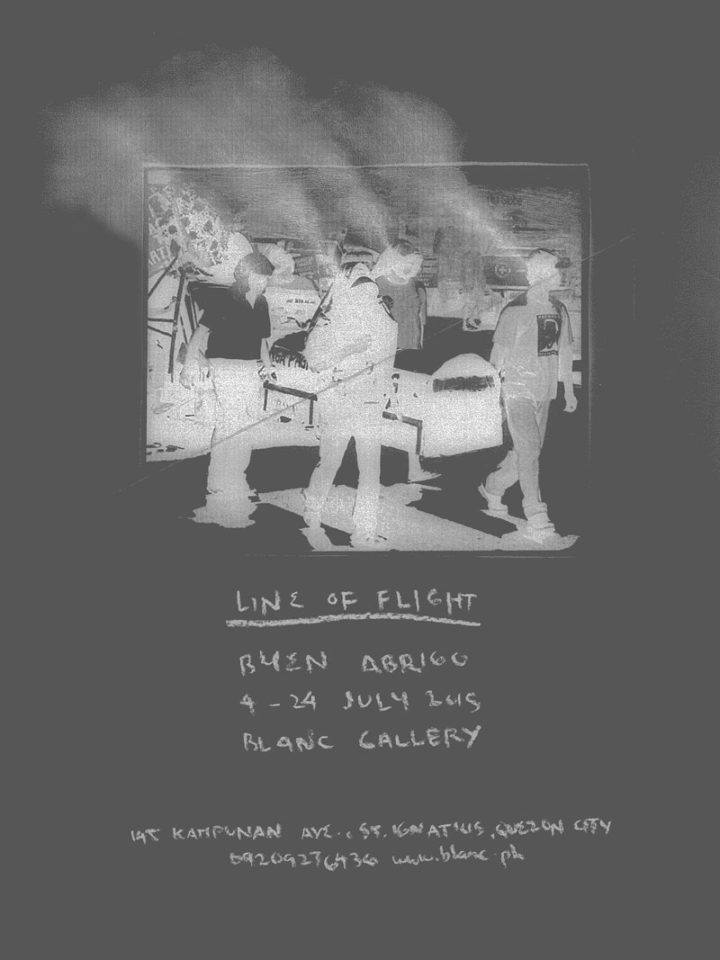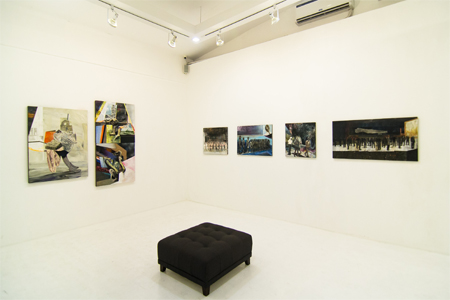
In his recent set of paintings, Buen Abrigo takes interest on historical photographs documenting our long-enduring and often largely misconceived relationship with the US. Record-fragments of an ongoing history of sugarcoated intervention and control that is deeply ingrained within our culture and continually influences how we govern or even think about ourselves today. Vestiges of how we are formed as a modern state and introduced to the (or as a) capital under the shadow of colonial rule and its repercussions fill the canvases. But here they appear with a seeming emphasis on
their own flatness and materiality rather than on their depth or content. As these planar shapes overlap, juxtapose, skew and cut across one another, so did the scenes they depict. This method of constructing a picture plane makes these historical scenes break down into anachronistic fragments, reducing them to scattered, faint memories.
Bright, intense color fields, painterly strokes, splashes and gestures interfere with the somber tones of the already obscure figurations. Looking at them beyond being mere compositional devices or distractions, they look quite like assorted cut-out patches from a painting made by somebody who’s branded as an Abstract Expressionist or a local Non-objective painter. Such are examples of practices that are well-known for that pursuit of ethereal sacred-philosophical truths and generalities as revealed by some purely imaginary forms – a concern which is far removed from anything political. Despite that fact, they were nonetheless assimilated by the respective regimes from which they are under as ideological tools well-fitted enough to serve as masks. In reference to some research articles regarding this matter1, one can discern a set of related ideals projected upon works from these artistic tendencies to suit propaganda needs. Ideals that are tied by a thread that can be traced back to an American influence.
The two aspects each stand at the opposite poles yet they are tightly bound to one another. Excavated ghosts from the mega-archive (i.e. the internet) interrupting a background of incongruous pieces of what would have been representations of freedom, democracy and cultural advancement. These inconsistencies create wide gaps that are very apparent as much as they are inseparable. What results in this conjoining are crammed and unstable surfaces of contention full of discrepant and irreconcilable viewpoint-truths. They appear as more of something that our eyes can be exposed of as to a computer screen rather than reveal itself as through reading a stable narrative-flow.
As paintings, the works attempt to imagine and construct a history (or histories) through a multiplicity of contradicting fragments. They will always look as if complete and unified but also inherently incoherent and irresolute – pretty much like our current state of affairs. Interestingly this quality of indeterminacy put these elements in a “perpetual state of becoming”2 on a shared plane where they coincide and clash – possibly drawing up new (mis-)readings and re-interpretations. Here, collage is the approach employed to detonate their inherited significations; a method that could potentially evoke lines of flight.
Line of flight, a concept attributed to Gilles Deleuze and Felix Guattari, is an abstract line that marks the edge of multiplicities. That is, a creative line that changes the nature of a multiplicity, in the sense of a rhizomatic web of known or existing relations, and connects them to others beyond it. It roughly refers to some creative and trans-formative agency that arises when established structures, hierarchy or networks of meanings and significations explode into a chaotic array of free associations. A destabilizing moment that is rife with the potential of (re)defining and extending the limits of the
territory of what is thought of as possible.
As these works attempt at removing the shroud of continuity and consistency that veils history, it becomes exposed as a turbid pool of differences consisting of informational fragments that actively obscure one another to the eyes of the reader. Given that it is a construction-invention of a past legacy that informs our present, there is always a struggle between conflicting forces and interests to piece together a narrative which would be established as the real. Today, we are in a circumstance where hegemonic forces have cemented their version of the story in the minds of the majority. It seems then that only great efforts of upheaval that draw lines of flight will be the ones able to destabilize imposed notions that are already cast in stone. It is in its aftermath that hopefully, fields that accommodate the formation of new identities and systems that are free from the dictates of totalizing self-interests will be opened up.
1 See: Flores, Patrick. “In the Defiles of Abstraction”. Kritika Kultura 23, 2014 and Saunders, Francis Stonor. “Modern art was CIA ‘weapon’”. www.independent.co.uk, (1995)
2 Kuspit, (1983)
WORKS
DOCUMENTATION














